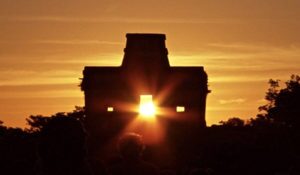
What makes Dzibilchaltún so perplexing are seven crudely made clay figurines found buried below the altar archaeologists have named Temple of the Seven Dolls. At its peak, Dzibilchaltún, which means “where there is writing on flat stones,” was one of the oldest settlements of the northwestern Maya lowlands of Yucátan in Mexico. Anciently, it was a large and complex community, engaged in the exploitation of nearby seaside resources, especially salt, and long-distance coastal and inland trade. In its heyday, the city had more than “8,000 buildings spread out over twenty five square miles, most of which are one or two-room platforms that once supported dwellings made of pole-and-thatch. Its population may have reached over 25,000 souls; at that time, it was the biggest city on the peninsula” (Kurjack, 1979 in Andrews, 1980).
______________________________________
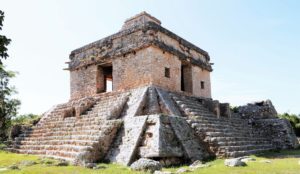
Temple of the Seven Dolls – ©georgefery.com
______________________________________
Located eight miles from present day Mérida, and seven miles from the coast, Dzibilchaltún’s earliest recorded permanent settlement dates from the Early Formative pre-Nabanchè Phase.1, 900BC. It was continually occupied from the middle to the late pre-Classic 500-250BC, with high and low occupation periods, up to the arrival of the Europeans in 1521. For the purpose of this story, we will focus on the city’s center and the Temple of the Seven Dolls, the easternmost major structure in the urban area where the figurines, or dolls, were found. Archaeologists refer to the temple as Structure 1-sub (Str.1-sub). The temple shares its spiritual powers with those of its westernmost counterpart, a temple known as Structure 66 (Str.66).
________________________________
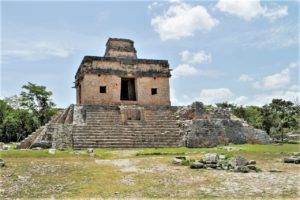
Entrance to the Sacred Plaza – ©georgefery.com
________________________________
The program of investigation and restoration at Dzibilchaltún was initiated by E. Wyllys Andrews IV in 1956, with the sponsorship of the National Geographic Society and the Middle American Research Institute at Tulane University, New Orleans, Louisiana. The archaeological team realized that the 7,000 tons of collapsed rubble identified with Structure 1 (Str.1) was irretrievably damaged and had to be removed, allowing for Str.1-sub, which was below it, to be reclaimed. Str.1-sub was built on an even older sanctuary, unlike those at other Maya sites in the Yucatán. The ancient city’s major structures and temples were painted with various bright colors, among which red was predominant. Str.1-sub, however, was painted white, and so was sacbe1, surfaced with white limestone, then called a “white road”— that is, a raised causeway, which ended at the terrace in front of the temple. Traditionally, in an urban context, an east-west causeway covered with white stucco was associated with the path of the sun, and the Temple of the Seven Dolls was built precisely where the sun rose at equinoxes. Of note is that the temple was named by archaeologists “Temple of the Dolls”, while in all probability its ancient name was “Temple of the Sun”. Its allegorical counterpart, Structure.66, may have been called “Temple of the Moon.”
______________________________

The Seven Dolls and Str.66, Str.1-sub and Str.66 partial map – Drawing by George E. Stuart, 1959 – ©Andrews-MARI
______________________________
Str.1-sub is located on the easternmost side of Dzibilchaltún, half a mile from the central plaza. The temple has four windows, unusual in Maya temples of that time, with two trapezoidal doors on both its east and west walls. There are two identical doors, but no windows, on the north and south walls. Str.1-sub, together with the three structures across its plaza and Stela 3 further west, is archetypal of an E-Group such as at Uaxactun. The windows on the east and west walls may have been used to observe the rise of other celestial bodies at dawn and at dusk, to ascertain the course of celestial bodies linked to either the Tzolkin 260-day Maya sacred calendar or the 365-day solar calendar, the Haab. Furthermore, the play of light and shadows that took place on March 21 and September 20 or 23 were strong beacons of the sun’s solsticial course. The first date signals the start of the seeding season, while the second was that of harvesting. The temple main doors on the east and west sides, and no windows on the opposite sides, underline the temple functions by their symmetry. With the four cardinal directions open (the four doors), the open roof of the tower (the zenith) and the dolls cache below the temple floor (the nadir), the sun god confirmed the solstice return when its rays lighted the main chamber floor at noon, above the seven dolls cache. This event directed the priest-shamans to start the seeding rituals in the temple.
In an agrarian based economy, the function of Str.1-sub allowed priest-shamans to observe and ascertain the cyclical rising and setting of the sun, the universal time-clock of agriculture. The monitoring of the unwavering repetition of the cycles of heavenly bodies correlates ritually with Str.1-sub as sun-fire-male-sunrise, and its counterpart Str. 66 as moon-water-female-sunset. The reason why the cycles of heavenly bodies were to be watched at dedicated times by priest-shamans was that since gods and deities were “mind-made” they responded like humans to neglect, contempt and anger. Love was not expected from the gods, for it had to be paid with blood and tears.
______________________________
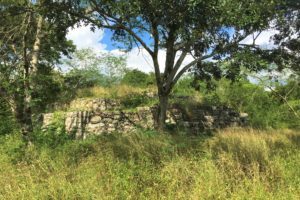
Structure.66 – ©georgefery.com
______________________________
Rituals in ancient communities followed the agrarian cycles under the auspices of their respective deities. The first sanctuaries were built for these mediators between the world at large (nature) and humankind (culture), because culture could not, on its own, control nature. Priest-shamans had to ensure the accuracy of the sun (K’inich Ahau, the sun-faced lord), which never failed to reappear at the exact same place, day after day, solstice after solstice, equinox after equinox. Priest-shamans were helped in their tasks by supplication and invocation rituals during which they addressed the deities of the vegetal world and the powerful god of rain. At times, individuals were praying to their ancestors, personal mediators in the “otherworld” with deities of the family.
Solsticial and equinoxial recurrences were closely observed. Important was the sun’s zenith event—when the sun reached the observer’s zenith, 90° above the horizon, which only happens between the Tropic of Cancer and the Tropic of Capricorn. Contreras offers an interesting hypothesis for monitoring this episode. “The high ceiling of the inner room of Str.1-sub forms a tower projecting above the temple roof. Str.1-sub tower’s ceiling may have been made of a lighter material to allow for temporary removal in order to let the sun rays at its zenith to light up the floor of the central chamber below” (Jobbova et al., 2018). Str.1-sub tower collapsed when Str.1 debris were removed in 1959, but its restoration shows a small doorway on the south side for access to its roof. At Dzibilchaltún’s latitude, the sun’s zenith at the spring solstice is traditionally associated with the beginning of the planting cycle and the rainy season.
The monitoring of the repetition of natural events was associated with “mind-made” deities, masters of the seasons and people’s subsistence. The character of the ceremonies, directed by priest-shamans under the auspices of the lords of the realm, were dedicated to the all-powerful rain god Cha’ak, second only in the Maya pantheon to K’inich Ahau, the sun god. Was the Temple of the Seven Dolls conceived allegorically as the “anchor” of the sun, with ceremonies and rituals traditionally associated with the seeding of the earth? Most likely.
And so the seven dolls, which were ritually “planted” by priest-shamans down a duct three feet deep, were dug into the floor at the center of the temple’s altar. Bates Littlehales rendering (1959, in Andrews.1980) depicts the re-enactment of the ceremony of the seven dolls that took place during the Decadent Period’s Chechem Phase (1200-1500AD). The climate record for the Yucatán shows that this ceremony took place within the time frame of recurrent droughts.
____________________________________
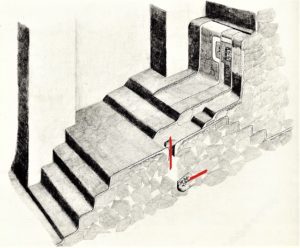
The Dolls Cache 3 — Drawing by George E. Stuart. 1959 ©Andrews-MARI
____________________________________
What was expected from rituals associated with the seven crudely made figurines? We do not know, and may never know. The figurines were described by archaeologists as displaying physical deformities. Andrews remarks “None of us had ever seen anything like them…we can only guess at their significance. Perhaps these little idols embodied the Maya priests’ formulas for curing disease” (1980). Of note is the fact that their number, seven, places them at the center of the culture’s spiritual world, at the intersection of the four cardinal directions, along with the zenith, the nadir, and the figurines’ position, believed to be the center of the community’s universe. The six females and one male figurines display oversized genitals (the male supports a disproportioned erect member). They are symbolic of the reproductive powers scattered by the sun, master of nature, a ritual found in most other Maya communities, as well as in other ancient cultures.
The disparity in gender, however, is puzzling and leads to the question: why six females and one male? Why not four and three or another mix? Since no consensus could be found with scholars, the next step was to ask respected local shamans (h’men) for their opinion on the gender disparity. A pertinent remark, that may be taken into consideration, “one male and a number of females in age of reproduction would secure the community’s survival, while conversely, one female among any number of males, would warrant the group’s extinction” (2020). A stern observation that may be grounded in the survival of our species’ long lost past.
The figurines are not unlike those made by children. However, they are not “dolls.” Andrews notes that “the tubular shaft at the bottom of which they were buried, a “psyco-duct” as we call it, was not sealed but left open to, we assume, allow these spirits of the tomb to communicate their mysterious powers to the human world above” (1959:107-108). Placed at the very heart of the temple, the figurines may have been the guardians to the portal of the “otherworld,” the place where eternal life rises over death. Their association with nature is symbolically linked with the roots of plants synonymous with the roots of life, for the figurines were made to never be seen.
Scattering rituals were coincident with climatic stress during periods of decreased rain or drought. Is there a correlation between these age-old rituals and the figurines? Probably, because there is no other rationale for the priest-shamans to literally “plant” these deformed crudely made figurines below the floor of the temple’s altar. Furthermore, the scattering of human seeds was still practiced by farmers in early twentieth century in parts of the Americas. It was believed to periodically reaffirm a common law of the “right of blood” for farmsteads inherited from ancestors, as opposed to the “right of land” claimed by invaders.
_____________________________
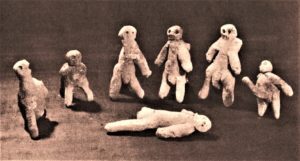
The Seven Dolls – ©Andrews-MARI
_____________________________
Archaeological data reported in Science (2018), show repeated phases of drought in the paleoclimate record from sediments in Lake Chinchancanab on the Yucatán peninsula. During the Maya Classic period (600-900AD), “…annual rain decreased between 41% and 54%, with intervals of up to 70% rainfall reduction during peak drought conditions” (Evans et al, 362:498-501). Furthermore, Metcalf and Davis, in Science & Public Policy Institute (SPPI, 2012), reported that “dry conditions, probably the driest of the Holocene, are recorded over the period 700-1200” (2007). Catastrophic natural events, and droughts in particular, were ascribed to the actions of malevolent deities that punished members of the priesthood and the nobility, who were at times overthrown as failed agents, for their lack of devotion. “Planting and rain-beckoning rituals are a common way in which past and present human communities have confronted the risk of drought across a range of environments across the world” (Jobbova et al, 2018).
_____________________________

Dolls Burial Reenactment – Bates Littlehales, 1959 ©Andrews-MARI
_____________________________
Both Merida and Dzibilchaltún are located inside the Chicxulub crater created by the impact of the asteroid that struck the earth within the Cretaceous-Paleogene (K-Pg) time-frame (66MYA), and caused the extinction event of the mega-fauna. The chain of cenotes or sinkholes, in this part of the peninsula is clustered outside the circle of the 93-mile impact zone, with a much smaller number found inside. In ancient agrarian societies, bodies of water, besides being vital to life, were at the heart of their religious beliefs and rituals because water was understood to be the essence of all life forms. Cenote Xlacah, (“old town” in Yucatec) is a major surface sinkhole at Dzibilchaltún. It was essential to the life of the city and its neighboring communities, given the lack of rivers in northern Yucatán and within the Chicxulub impact zone in particular. Xlacah’s surface area is bigger (328 feet x 657 feet) than the Sacred Well at Chichén Itzá (164×200 feet x 65 feet deep). It also is much deeper, at 144 feet. Its surface waters, however, are less than ten feet below the rim. Rituals associated with Xlacah were complementary to those that took place in the Temple of the Seven Dolls and in its western counter part, Str. 66. The cenote’s waters and its associated deities were recognized to complement and balance each temple’s predominance, that of the sun and the moon. After all, Xlacah was Cha’ak’s home, “the powerful god of storms, lightning, and life-giving rain” (God.B, Shellhass, 1904) .
Within this mythological context, Xlacah was understood to be the anchor of the permanence and persistence of life, mediator of the nature-culture dichotomy found in the beliefs of ancient societies. In addition to Xlacah, over “ninety-five man-made wells were found in Dzibilchaltún’s twenty-plus square miles populated area” (Kurjack, 1974). They were mostly hand-dug holes, since the water table is but a few feet below the surface. Unlike small wells, however, large cenotes are replenished by circulating underground water, and cleaned by schools of tiny fish and aquatic plants. Located at the southwestern corner of the city’s Central Plaza, Xlacah represents, in Coggins report “…the south and down, or the entrance and exit from the waters of the underworld” (1983:49-23). At its bottom, Xlacah’s floor slopes sharply down then levels off, continuing to an unknown distance in pitch blackness.
___________________________
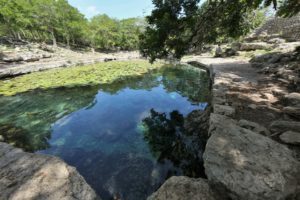
Cenote Xlacah – ©georgefery.com
___________________________
The cenote was the focus of rituals witnessed by more than 3,000 broken ceramic and water jars found at its bottom, together with portions of at least eight human skeletons and animal bones. Its waters were used for both daily needs and rituals that did not involve human or animal sacrifice. The few remains found, therefore, were probably those of people and animals that drowned while collecting water. Surface and underground cenotes are mirrors of two worlds, recognized as Cha’ak’s home, “patron of agriculture and one of the oldest continuously worshipped god of ancient Mesoamerica” (Miller+Taube, 1993). “Xlacah represent the center of Dzibilchaltún’s agrarian universe, its pivotal axis” (Lothrop, 1952, Tozzer, 1957). The powerful god of rain, lightning, and thunder was the master of life and fear, because should rain fail, the life giving maize harvest (corn-Zea mays subsp.) would wither, and lead to hunger, conflict and death. The Mayans have a deep reverence for maize for, in their mythology, the gods created them out of maize dough. It therefore is not only their main staple and daily sustenance, but foremost, it is associated with their very existence, their soul.
_________________________

Str.12 and Stela.3 – ©georgefery.com
_________________________
The half-mile causeway 1 runs in a straight line from the city’s central plaza to the Temple of the Seven Dolls. One hundred forty-three feet west of the temple are three structures with two rooms each, built astride the causeway, that controlled the approach to the temple, together with a high defensive stone wall in front (now gone). Access was limited through two narrow passageways, between the central pair of rooms, and underline the sanctity of the complex. Four hundred and forty-five feet west of the defensive wall stood Structure 12 (Str.12), a four-stairway/six-steps quadrangular platform with an eleven-foot-tall limestone monolith, Stela 3. It was covered with stucco and painted with figures of the Maya pantheon, now lost to time. It is one of about thirty such monuments on the site and squarely faces the west side door of the Temple of the Seven Dolls. Its position relative to the temple, however, indicates that it was most probably used as a sighting device reciprocal to those of Str.1-sub for the observation of heavenly bodies through either or both the east-west doors or the windows when sighting was deliberately blocked by Stela 3. Of interest is the fact that, from an allegorical standpoint, structures were important but no more so than the play of light and shadows at dedicated times, such as at solstices and equinoxes. Following the path of the sun, the shadows had the same ritual value as that of structures or select natural landmarks.
Architecturally similar to Str.1-sub, Str.66 is radially symmetrical and is located two and a half miles from Str.1-sub, at the western end of sacbe 2. However, it has not been restored, hence the limited information on both structure and remains. The similarity with the Seven Dolls complex, however, is striking and extends to Str.63 with a four-stairway/six-steps quadrangular platform and an eleven-foot limestone monolith, Stela 21, located 145 feet east of Str.66’s plaza, and built squarely on causeway 2. Like Stela 3 to the east, Stela 21 was covered with stucco and painted with figures of the Maya pantheon, now lost to time. Andrews refers to Str.66 as “a mirror image of the Seven Dolls group” (1961), dedicated to the moon, counterpart to Str.1-sub, which was dedicated to the sun. Like the Temple of the Seven Dolls, it also had its access restricted by Str.64 and Str.65, which were built across its plaza.
___________________________
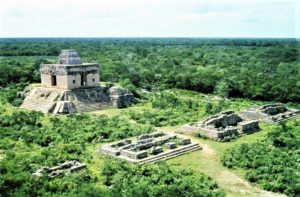
Str.12 and Stela.3 – Seven Dolls Complex, Edward B. Kurjack ©georgefery.com
___________________________
The first sanctuaries were built for deities, mediators between an unmanageable nature and humankind, to persuade them through prayers and sacrifices to provide or facilitate food. From early human history, daily sustenance was an enduring concern. Dependence on the vagaries of the Yucatán’s seasons, climate, and the “mood of the gods,” kept communities in constant dread. Natural events such as flood, drought, or insect plagues, brought constant fear, anxiety, and hunger. It is not surprising then that communities sought solace and help from their shamans, the needed go-betweens to commune with the overbearing deities of nature, to help people carry their unpredictable burdens.
____________________________

Chac Xib Cha’ak Ceremony – ©georgefery.com
____________________________
Yucatec farmers (milperos) today tend their corn fields (milpas) as in the past, with utmost devotion. After planting in early spring, a Chac Xib’Cha’ak ceremony takes place in the field. The ceremony is related to the ancient god Cha’ak, integral to the seeding process before the first rains. It is conducted by h’men (a term that means “he who makes”) and their apprentices (idzat), together with the milpa owner, other farmers and community leaders. All pray to the ancient gods and their associated Christian deities on a field altar that answers to ancestral rituals, adorned with plants and fruits from the land. Young boys crouch at each corner of the altar and mimic the croak of frogs calling for rain. As in the past, the h’men’s rain-beckoning rituals are a common way to pray for the blessed rains for fear that it may be withheld or delayed by malevolent forces.
For centuries, ancient gods and deities were the heartbeat of this great city and helped people cope with environmental stress such as drought, locusts, hurricanes, and other natural events. As is the case for all rituals, prayers and invocations, they helped people contend with an inherently unpredictable nature. The shadows of centuries inexorably blurred gods and deities, but below Str.1-sub altar, undisturbed by time and events, the Seven Dolls kept their relentless watch over Dzibilchaltún.
___________________________

Sunrise on Vernal Equinox – ©turitransmerida.com
___________________________
Bibliography / References:
Edward B. Kurjack, 1974 – Prehistoric Lowland Maya Community and Social Organization, A Case Study at Dzibilchaltun, Yucatan, Mexico.
E. Willis Andrews.IV, 1980 – Excavations at Dzibilchaltun, Yucatan, Mexico.
Clemency Coggins, 1983 – The Stucco Decoration and Architectural Assemblage of Structure-1.sub, Dzibilchaltun, Yucatan, Mexico.
MARI-Middle American Research Institute, Tulane University, New Orleans, LA
Orlando Josué Casares Contreras, 2001 – Una Revisión Arqueoastronómica a la Estructura 1-Sub de Dzilbilchaltún, Yucatán – Universidad Autónoma de Yucatán, Merida.
Eva Jobbova, Christophe Helkme & Andrew Bevan, 2018 – Ritual Responses to Drought: An Examination of Ritual Expressions in Classic Maya Written Sources – Human Ecology
Mary Miller & Karl Taube,1993 – The Gods and Symbols of Ancient Mexico and the Maya
Evans et al, 362:498-501). Science (2018)
____________________________




